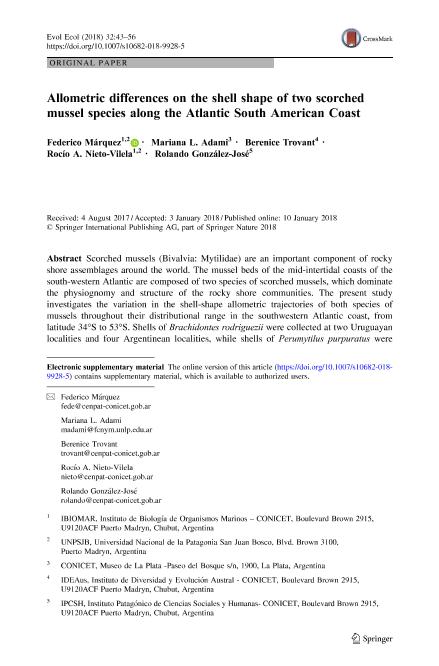Mostrar el registro sencillo del ítem
dc.contributor.author
Marquez, Federico

dc.contributor.author
Adami, Mariana Laura

dc.contributor.author
Trovant, Berenice

dc.contributor.author
Nieto Vilela, Rocío Aimé

dc.contributor.author
González José, Rolando

dc.date.available
2019-11-07T21:47:55Z
dc.date.issued
2018-02
dc.identifier.citation
Marquez, Federico; Adami, Mariana Laura; Trovant, Berenice; Nieto Vilela, Rocío Aimé; González José, Rolando; Allometric differences on the shell shape of two scorched mussel species along the Atlantic South American Coast
; Springer; Evolutionary Ecology; 32; 1; 2-2018; 43-56
dc.identifier.issn
0269-7653
dc.identifier.uri
http://hdl.handle.net/11336/88279
dc.description.abstract
Scorched mussels (Bivalvia: Mytilidae) are an important component of rocky shore assemblages around the world. The mussel beds of the mid-intertidal coasts of the south-western Atlantic are composed of two species of scorched mussels, which dominate the physiognomy and structure of the rocky shore communities. The present study investigates the variation in the shell-shape allometric trajectories of both species of mussels throughout their distributional range in the southwestern Atlantic coast, from latitude 34°S to 53°S. Shells of Brachidontes rodriguezii were collected at two Uruguayan localities and four Argentinean localities, while shells of Perumytilus purpuratus were collected at six Argentinean localities. Shell shapes of the specimens were studied by geometric morphometrics using landmark and semi-landmark methods. Different evolutionary histories and thermal regimes characterize these two species. Brachidontes rodriguezii seems to have a long history in the region and is present in a restricted area, the warm temperate region of the south-western Atlantic, while P. purpuratus seems to have a recent history and is present in a wide thermal range, involving the cold-temperate regions of the south-western Atlantic and south-eastern Pacific and the warm-temperate region of the south-eastern Pacific. Based on these considerations, we prompt the hypothesis that allometric trajectories of P. purpuratus shell shape is more variable and adapted to a specific habitat than B. rodriguezii. The impact of allometry was larger in P. purpuratus than in B. rodriguezii. Graphical evidence was gathered, showing that these two species differ in allometric growth forms and that the allometric shell morphology changes reflect environmental constraints and adaptation. While the intertidal mussel beds of the South American coasts are ecologically similar in appearance, we found that the allometric variation of the scorched mussels occurs in response to diverging evolutionary processes such as phenotypic plasticity in P. purpuratus and canalization in B. rodriguezii.
dc.format
application/pdf
dc.language.iso
eng
dc.publisher
Springer

dc.rights
info:eu-repo/semantics/openAccess
dc.rights.uri
https://creativecommons.org/licenses/by-nc-sa/2.5/ar/
dc.subject
ONTOGENY
dc.subject
SHELL SHAPE VARIATION
dc.subject
SOUTHWESTERN ATLANTIC
dc.subject
PLASTICITY
dc.subject
CANALIZATION
dc.subject.classification
Biología Marina, Limnología

dc.subject.classification
Ciencias Biológicas

dc.subject.classification
CIENCIAS NATURALES Y EXACTAS

dc.title
Allometric differences on the shell shape of two scorched mussel species along the Atlantic South American Coast
dc.type
info:eu-repo/semantics/article
dc.type
info:ar-repo/semantics/artículo
dc.type
info:eu-repo/semantics/publishedVersion
dc.date.updated
2019-10-22T15:03:49Z
dc.identifier.eissn
1573-8477
dc.journal.volume
32
dc.journal.number
1
dc.journal.pagination
43-56
dc.journal.pais
Alemania

dc.journal.ciudad
Berlin
dc.description.fil
Fil: Marquez, Federico. Consejo Nacional de Investigaciones Científicas y Técnicas. Centro Científico Tecnológico Conicet - Centro Nacional Patagónico. Instituto de Biología de Organismos Marinos; Argentina
dc.description.fil
Fil: Adami, Mariana Laura. Consejo Nacional de Investigaciones Científicas y Técnicas. Centro Científico Tecnológico Conicet - La Plata; Argentina
dc.description.fil
Fil: Trovant, Berenice. Consejo Nacional de Investigaciones Científicas y Técnicas. Centro Científico Tecnológico Conicet - Centro Nacional Patagónico. Instituto de Diversidad y Evolución Austral; Argentina
dc.description.fil
Fil: Nieto Vilela, Rocío Aimé. Consejo Nacional de Investigaciones Científicas y Técnicas. Centro Científico Tecnológico Conicet - Centro Nacional Patagónico. Instituto de Biología de Organismos Marinos; Argentina
dc.description.fil
Fil: González José, Rolando. Consejo Nacional de Investigaciones Científicas y Técnicas. Centro Científico Tecnológico Conicet - Centro Nacional Patagónico. Instituto Patagónico de Ciencias Sociales y Humanas; Argentina
dc.journal.title
Evolutionary Ecology

dc.relation.alternativeid
info:eu-repo/semantics/altIdentifier/url/https://link.springer.com/article/10.1007%2Fs10682-018-9928-5
dc.relation.alternativeid
info:eu-repo/semantics/altIdentifier/doi/https://doi.org/10.1007/s10682-018-9928-5
Archivos asociados
